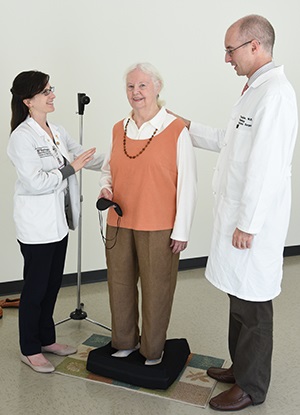By Julia Evangelou Strait
Enhancing hearing appears to improve balance in older adults with hearing loss, according to new research from Washington University School of Medicine in St. Louis. Patients with hearing aids in both ears performed better on standard balance tests when their hearing aids were turned on compared with when they were off.
The small study, which appears in the journal The Laryngoscope, involved only 14 people ages 65 to 91 but is the first to demonstrate that sound information, separate from the balance system of the inner ear, contributes to maintaining the body’s stability. The study lends support to the idea that improving hearing through hearing aids or cochlear implants may help reduce the risk of falls in older people.
“We don’t think it’s just that wearing hearing aids makes the person more alert,” said senior author Timothy E. Hullar, MD, professor of otolaryngology at the School of Medicine. “The participants appeared to be using the sound information coming through their hearing aids as auditory reference points or landmarks to help maintain balance. It’s a bit like using your eyes to tell where you are in space. If we turn out the lights, people sway a little bit — more than they would if they could see. This study suggests that opening your ears also gives you information about balance.”

Timothy Hullar, MD, (right) and medical student Miranda Colletta help patient Audrey Miller prepare for a balance test. Older adults with hearing loss appeared to perform better on balance tests with both hearing aids on, according to Hullar’s research. Photo Credit: Robert Boston.
All participants served as their own controls, performing the balance tests with and without their hearing aids turned on. Since the researchers were interested in examining the effect of hearing, all tests were conducted in the presence of a sound source producing white noise, similar to the sound of radio static.
In one test, subjects’ eyes were covered as they stood with their feet together on a thick foam pad. In a second, more difficult task, patients stood on the floor with one foot in front of the other, heel to toe, also with no visual cues for balance. Patients were timed to see how long they could stand in these positions without moving their arms or feet, or requiring the aid of another person to maintain balance.
Several of the participants could maintain stability on the foam pad for at least 30 seconds (which is the considered normal), whether their hearing aids were on or not. But those having more difficulty with balance in this test performed better when their hearing aids were on. And the improvement in performance was even more apparent in the more challenging balance test.
“We wanted to see if we could detect an improvement even in people who did very well on the foam test,” Hullar said. “And we found, indeed, their balance improved during the harder test with their hearing aids on.”
For the foam pad test, patients maintained balance an average of 17 seconds with hearing aids off. With hearing aids on, this average increased to almost 26 seconds. And in the more difficult heel-to-toe test, patients remained stable an average of 5 seconds with hearing aids off. With them on, this time increased to an average of 10 seconds. Even with the small number of patients in the trial, both time differences were statistically significant.
Although patients could tell whether their hearing aids were on or off, the researchers randomized the order of the conditions in which each patient performed these tests, so that some performed the tests with hearing aids on first and some started with them off.
Hullar pointed out that many of the study patients did not report being consciously aware that they had performed better on these tests when their hearing aids were working. But he said he has heard anecdotal evidence that some people notice a difference.
“Many of my patients say their balance is better when they’re wearing hearing aids or cochlear implants,” Hullar said. “We wanted to find out if improved hearing really has a measurable effect on balance. And the metric that we use — how many seconds can you stand on a piece of foam — has a well-documented relationship to risk of falling.
“This is a small study,” Hullar added. “Obviously it needs to be repeated in a much larger study, and we’re seeking funding to do that.”
This work was supported by the Washington University Institute of Clinical and Translational Sciences grants UL1 TR000448 and TL1 TR000449 from the National Center for Advancing Translational Sciences.
Rumalla K, Karim AM, Hullar TE. The effect of hearing aids on postural stability. The Laryngoscope. October 2014.
Washington University School of Medicine’s 2,100 employed and volunteer faculty physicians also are the medical staff of Barnes-Jewish and St. Louis Children’s hospitals. The School of Medicine is one of the leading medical research, teaching and patient-care institutions in the nation, currently ranked sixth in the nation by U.S. News & World Report. Through its affiliations with Barnes-Jewish and St. Louis Children’s hospitals, the School of Medicine is linked to BJC HealthCare.

